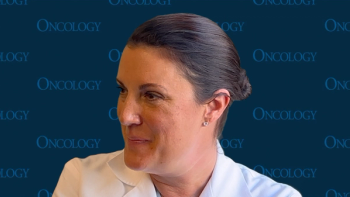
Characterizing Tumor Cell Diversity with AI
“Developments that take high-dimensional data and come up with interpretable insights…are going to play an increasing role,” says Smita Krishnaswamy, PhD.
In this episode, CancerNetwork® spoke with Smita Krishnaswamy, PhD, an associate professor in Genetics and Computer Science at the Yale Center for Biomedical Data Science and Yale Cancer Center, about findings from a study published in Cancer Discovery. Therein, an AI tool, the Archetypal Analysis Network (AAnet), aided in characterizing the diversity of individual tumor cells in triple-negative breast cancer (TNBC).
Krishnaswamy explained that the application of AAnet to primary TNBC tumors revealed 5 distinct archetypal states. Each of these states possesses unique spatial configurations, metabolic pathways, and gene expression signatures. She stated that a granular understanding of tumor composition is crucial, as it highlights the varied characteristics of cells that contribute to tumor growth and progression.
When investigators examined metastatic sites—including the lung, liver, and lymph nodes—they found that the same archetypes identified in primary tumors were largely preserved. Although minor variations were observed, such as the absence of a hypoxic archetype in lung metastases or an additional archetype in some sites, the overarching heterogeneity present in the primary tumor was consistently recreated in the metastatic lesions. This suggested that the diverse cellular ecosystem of the primary tumor is essential for establishing and sustaining metastatic growth.
A significant finding from this research is the potential for targeting specific archetypal cell types to disrupt tumor progression. Krishnaswamy explained that by identifying and ablating certain cellular signatures, the incidence of metastatic tumors could be reduced. An example she highlighted was the hypoxic archetype, which heavily relies on the glycolysis pathway. By experimentally knocking down GLUT3, a glucose transporter critical to this pathway, in a mouse model, the researchers observed a decrease in the occurrence of this specific type of metastasis.
The existence of these discrete archetypal states, alongside intermediate cell types, points to a dynamic continuum within the tumor, suggesting that cells can transition between these states. This fluidity, Krishnaswamy suggested, underscores the adaptive nature of cancer. Investigators hypothesized that a proliferative archetype might initiate metastasis, with other archetypes subsequently developing to support the metastatic process. The consistent presence of similar heterogeneity in metastases further supports the notion that a combination of different cell types is necessary for tumor sustenance. Therefore, disrupting key archetypes could prove to be a powerful therapeutic strategy.
According to Krishnaswamy, AAnet holds significant promise for clinical application. It can be directly applied to human clinical samples of TNBC, provided single-cell data are available from tumor biopsies. Analyzing these data could reveal the specific heterogeneity and cellular states within a patient's tumor, allowing for the study of their unique molecular signatures. While bulk tumor data could potentially be integrated, the increasing prevalence of single-cell technologies is seen as the future for comprehensively measuring tumor heterogeneity.
Beyond its diagnostic potential, AAnet can also be used to monitor treatment responses, such as the effects of chemotherapy on tumor heterogeneity, and to identify specific cell types that contribute to treatment resistance. The versatility of AAnet extends to other heterogeneous cancers. For example, it has already been applied to pancreatic cancer to study cell types associated with obesity-driven progression and how archetypes evolve over time. This tool is broadly applicable to any cancer type to pinpoint salient cell types, particularly those linked to metastatic or epithelial-mesenchymal transition (EMT)-like signatures.
Beyond AAnet, Krishnaswamy’s lab is also actively exploring the dynamics of cell types, investigating how initial cell populations progress into more advanced ones as cancer evolves. This is being achieved through innovative neural network flows, which can infer continuous cellular progression from static single-cell snapshot data. These advancements, including methods like TrajectoryNet, Manifold Interpolating Optimal-Transport Flows (MIOFlow), and Flow Matching, may revolutionize the field’s understanding of cancer initiation, metastasis, and the complex underlying cellular networks.
To Krishnaswamy, deep neural networks and other AI methodologies are proving indispensable in the rapidly evolving landscape of cancer research. Future AI tools, specifically those designed to comprehend the intricate geometry and topology of cellular state spaces within tumors, will be vital for achieving new discoveries in cancer.
Reference
Venkat A, Youlten SE, San Juan BP, et al. AAnet resolves a continuum of spatially-localized cell states to unveil intratumoral heterogeneity. Cancer Discov. Published online June 24, 2025. doi:10.1158/2159-8290.CD-24-0684
Newsletter
Stay up to date on recent advances in the multidisciplinary approach to cancer.

















































































